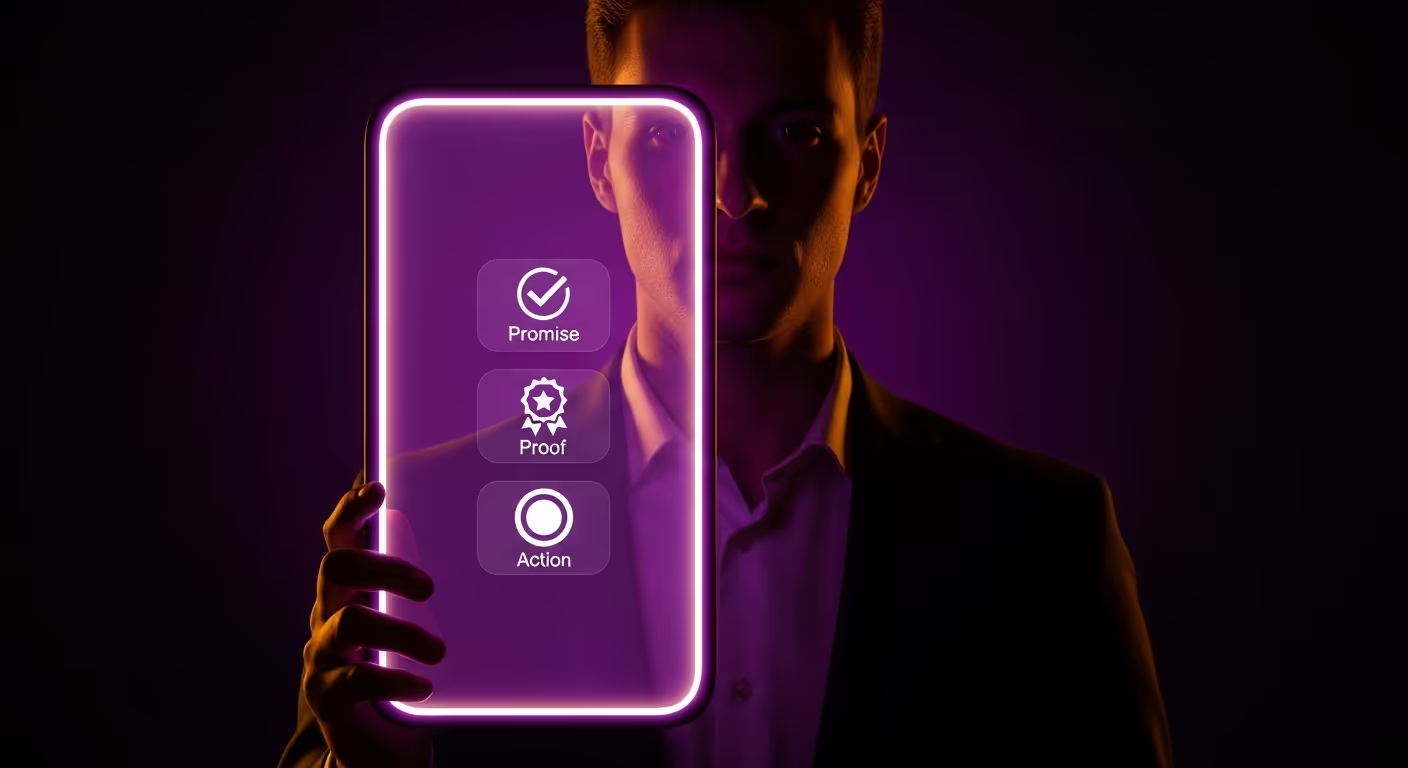
Websites
Homepage layout that converts in 2025
A simple fold: clear promise, proof, and one strong call to action. Then answer key questions fast.

The job of the homepage
Your homepage is not a brochure. It is a quick decision tool. In the first view, a visitor should understand what you do, why they should trust you, and what to click next. Everything else belongs lower on the page. In 2025, attention is short, mobile rules, and searchers arrive from specific queries. A clean layout wins.
The first fold: promise, proof, action
The first view sets the tone. Keep three elements in play and resist the urge to add more:
- Promise: One line that says the outcome you deliver.
- Proof: One short stat, logo row, or star quote near the promise.
- Action: One clear button that matches the main thing you sell.
That is it. Do not add extra links, sliders, or long text. If the promise is clear and the action is obvious, people will scroll or click.
Write a promise that earns the click
A good promise says the result and who it is for. It avoids buzzwords. It uses short words and plain order.
- Weak: “Innovative solutions for the digital age.”
- Strong: “Websites and content that grow your business.”
Add a short line below if needed: one sentence that sets scope, like “Monthly plans that include site, blog, and social.” Keep it under 18 words. If you need more than that, save it for a lower section.
Place proof close to the claim
Proof works when it sits next to the promise it supports. Add one stat, one logo row, or one short quote. Make it tight and true.
- “100k+ monthly impressions after six months”
- Logos of two or three clients, not a noisy grid
- “Now we get daily table requests” — real client name
Keep proof short so the button stays in view. The goal is to give nervous visitors a reason to believe and click.
One action per page, one button per fold
Pick one main action for the whole page. Examples: “See pricing” or “Book a call.” Use that button at the top and repeat it near the end. Lower in the page, you can add a soft link for people who need to learn more first, like “How it works.”
Section 2: how you help
After the first fold, explain your core value in a short block. Use a heading that restates the outcome and a two or three line paragraph. Then show three to four tiles with a title and a one line description.
- Traffic that converts: We target real search intent.
- Content that works: Posts that answer common questions.
- Search-ready setup: Fast, clean, and easy to crawl.
- Growth you can track: Monthly charts with progress.
End the section with a small link, not another big button. Save the button for the next clear step.
Section 3: show the product
People buy when they can picture the thing. Use a clean visual and a short paragraph that names the parts they get. Keep the copy focused on outcomes.
- Website: Fast, mobile, built for SEO and AEO.
- Blog: Weekly posts that match what people ask.
- Social: Daily presence, reels, and stories.
- Reporting: Clear charts and short notes each month.
Use real images when you can. Crop tight. Avoid mockups with tiny text. The eye should catch the idea, not fight small UI.
Section 4: proof with context
Now that the visitor knows what you sell, give deeper proof. Share one or two cases with a chart or a number and a one line outcome. Keep dates visible so it reads real.
- Crustello: 100k+ monthly Google Search impressions in six months.
- Shamrock Pub: Daily table requests after the new site and content plan.
Add a link to “See all projects.” Do not flood the page with ten tiles. One or two strong examples beat a noisy grid.
Section 5: how it works
Use three steps. Name each step with a verb and keep the explanation short. Visitors want a plan, not jargon.
- Build the foundation: We launch a fast site with clean SEO.
- Run the content: We post blogs, reels, and stories on schedule.
- Show the results: We send charts and next steps each month.
Section 6: pricing preview
Give a quick look at your plans. Do not list every line item. The goal is to help people self select, then click to see the full table.
- Basic: Site, weekly blogs, steady social. $2,000/mo.
- Pro: More content and reels. $3,500/mo.
- Premium: High volume and priority turnarounds. $6,000/mo.
Use one button: “See full pricing.”
Section 7: FAQ preview
Pick three short questions that remove friction. Link to the full FAQ page.
- How long to see results?
- Do I keep my site?
- Can I approve content?
Section 8: final call to action
Close with a simple restatement of your promise and one button. A soft link can sit beside it for people who want to talk first.
- Button: Start your plan
- Link: Book a call
Mobile first rules
Most visitors see your site on a phone. Design for that view first. Then scale up. These rules keep the page clear on small screens.
- Keep headings under two lines.
- Use short paragraphs and generous line height.
- Stack tiles in a simple one column grid.
- Use real buttons with full width on the main action.
- Make logos and quotes large enough to read at a glance.
Speed and clarity checks
Fast pages convert better. Clarity keeps people from bouncing. Run these checks before launch.
- Compress images. Use modern formats and lazy loading.
- Limit heavy scripts. Remove unused apps and embeds.
- Keep contrast high for text on dark backgrounds.
- Use alt text that reflects visible content.
- Test the page on a budget phone and a slow network.
Copy tips that lift conversions
Small edits can make big gains. These patterns work across many sites.
- Use verbs. “Get, See, Start” beats “Learn more.”
- Front load value in headings. Put the point first.
- Replace fluff with proof. One stat beats five adjectives.
- Match link text to the target page. No vague anchors.
- Mirror the visitor’s words in your copy. Use their phrasing from calls and emails.
Header and footer that help
The header should be light. Keep five or fewer links. Add a clear button that matches your main action. The footer can hold legal pages, contact info, and a small site map for crawlers and humans who like to scan.
Test one change at a time
Do not redesign every month. Run small tests that you can measure. Change only one thing per test window so the result means something.
- Button text: “See pricing” vs “Start your plan.”
- Proof line: a stat vs a quote.
- Hero image: person vs product.
- Order of sections: “How it works” above or below proof.
Use simple goals like click-through on the hero button and scroll depth to the pricing preview. Let tests run long enough to be sure.
Keep the homepage current
Set a monthly check. Update proof lines with fresh numbers. Swap one case study for a newer one. Remove dead links. Keep the page light and clean. Your homepage is the top of your funnel and the first touch for many people. Treat it like your storefront.
A quick checklist you can copy
Above the fold:- One-line promise- One proof line or logo row- One primary buttonThen:- Short value section with 3–4 tiles- Visual of what you deliver- One or two cases with numbers- Simple three-step process- Pricing preview and one button- FAQ preview- Final call to action
Final note
A homepage that converts is simple on purpose. Say the promise, back it with proof, and give one clear way to act. Then answer the most common questions without clutter. Keep it fast. Keep it honest. Keep it focused on helping a visitor decide. That is how you turn visits into leads in 2025.
read more
Similar articles

Service page template that converts

Above-the-fold best practices
Let’s grow
Start your monthly marketing system today
No guesswork, no back-and-forth. Just one team managing your website, content, and social. Built to bring in traffic and results.




